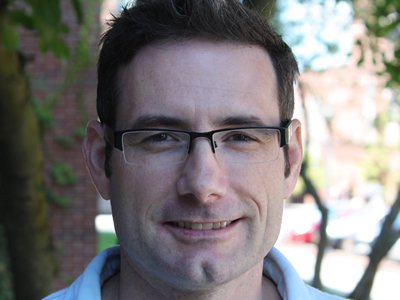Turning Beaches into Hillsides
East Coast Landscape Evolution Influenced by Many Geological Factors

For an ancient, flat shoreline, North America’s east coast is awfully bumpy. A new, comprehensive computer model shows that multiple surface and deep Earth processes influenced elevation change in this region. Not only do these models provide insight into how the landscape formed, but also how the shoreline may change in the future.
“We lack a complete geological record for changes during the period of intense landscape evolution—this is where modeling comes in,” says Robert Moucha, assistant professor of Earth sciences.
Reported Jan. 10 in Global and Planetary Change by Moucha and coauthor and Ph.D. candidate Gregory A. Ruetenik, multiple factors—including warping of the Earth’s crust and sea level changes—are responsible for the region’s varied landscape.
Focusing on a period known as the Mid-Pleiocene Warm Period (MPWP), the two explored factors influence landscape evolution of the Orangeburg scarp, the area between northeast Florida and northern Virginia.
Because the Orangeburg scarp is a passive margin, meaning tectonic plates aren’t converging to deform the Earth’s crust, other forces must have contributed to the elevation changes of tens of meters across the scarp. Additionally, the elevation in general is higher than expected from sea level fall post-Pleiocene, Moucha says.
“Because the scarp is a paleo shoreline it must have been flat along the coast when it formed, and after sea level fell around 3 million years ago because of the growth of Greenland and Antarctic ice sheets, it should have remained flat,” he says. “Something must have warped it and uplifted it, but the area is passive, so where did this warping and uplift come from?”
Some movement comes from solid Earth deformation, which is still responding to the loss of glaciers nearly 12,000 years ago. Adjustments also happen in response to convective mantle flow roughly 70 miles beneath the surface, Moucha says.
A previous study modeled the effect of such forces on the scarp, but Moucha felt that more could still be done: “The paper dealt only with the deep Earth component of the deformation. While the magnitudes of identified deformation were in the ball park, the fit of the model left much to be desired and that always troubled me.”
Moucha and Ruetenik brought together the effects of deep Earth processes with that of surface processes and sedimentation in a new, comprehensive model. By inputting components that operate on different timescales, the researchers were able to better describe the diverse forces responsible for the warping and uplifting of the Orangeburg scarp.
“The most important thing we learned from our models is that you need both components to sufficiently match the observed deformation. On their own, they do a poor a job and can lead, for example, to erroneous conclusions about the amount of sea level change required to explain the observed elevation of a paleo shoreline,” Moucha says.
Peering into the past can also yield insight to future shoreline changes. The solid Earth is still relaxing in response to post-glacial thaw, which affects the mid-Atlantic coast in particular, Moucha says. Additionally, predicting the amount of sea level rise based on specific ice sheets melting in Greenland or Antarctica gives insight to what coastal communities may need to prepare for in a warming world.
“Does the current increase in atmospheric carbon dioxide mean that surface temperatures will increase by 2-3 degrees like they did in the MPWP? If so, what impact will that have on ice sheets, and thus sea level? These are some of the questions we as community are trying to answer,” Moucha says.
This research was funded by Syracuse University.
